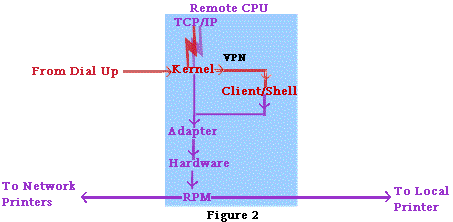

VPN (Virtual Private Network) is a network with some public segments such as
phone lines or Internet
connection in which data passing over its public segments is encrypted to achieve
secure communications.
TCP/IP (figure 1) encrypted data (red) coming from the Lab System via a
VPN dial up and through the Internet
via a VPN server is received at the Remote System. Both encrypted
(red) and non-encrypted (purple) data is
being received by the remote system.

Figure 2 shows how
software running on a PC communicates with the lab system's firewall, which
consists of a
Kernel and a Client/Shell. The Kernel can determine if outgoing or incoming
data is going to or coming from the
lab system, needs be encrypted or decrypted. You can freely use the Internet
(purple data) while secure
communications is going on, but when the lab systemís firewall connects to
the PC (red data) the Kernel invokes
Client/Shell in order to exchange an encryption key with the lab systemís
firewall and begins to decrypt the data.
The decrypted data is shown in purple coming from the kernel and entering the
adapter and other hardware.

Printer data that is decrypted by
the Client/Shell is passed to the RPM (Remote Print Manager) which in turn is
sent to a local or network printers.
RPM is a TCP/IP print server that
allows print clients to send print requests directly to a PC over a network or
the
Internet. Multiple named queues can be defined on your PC that will access local
or network printers, as a results
one PC can accept multiple print jobs from the lab system.
More Details On Remote Print Manager.
For additional information on Virtual Private Networks follow the links below.
VPN Basics SSHģ Secure ShellTM Check Point VPN Server